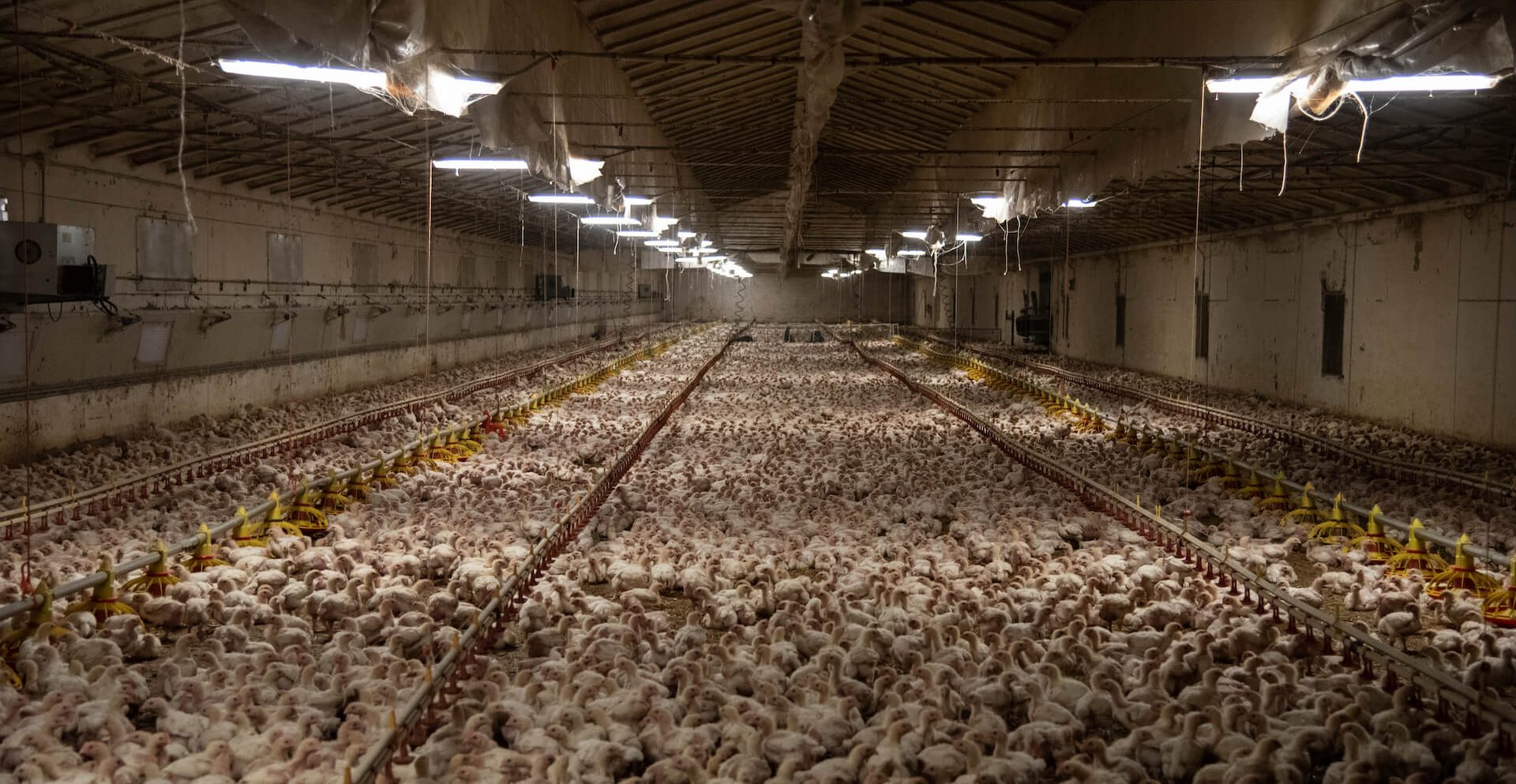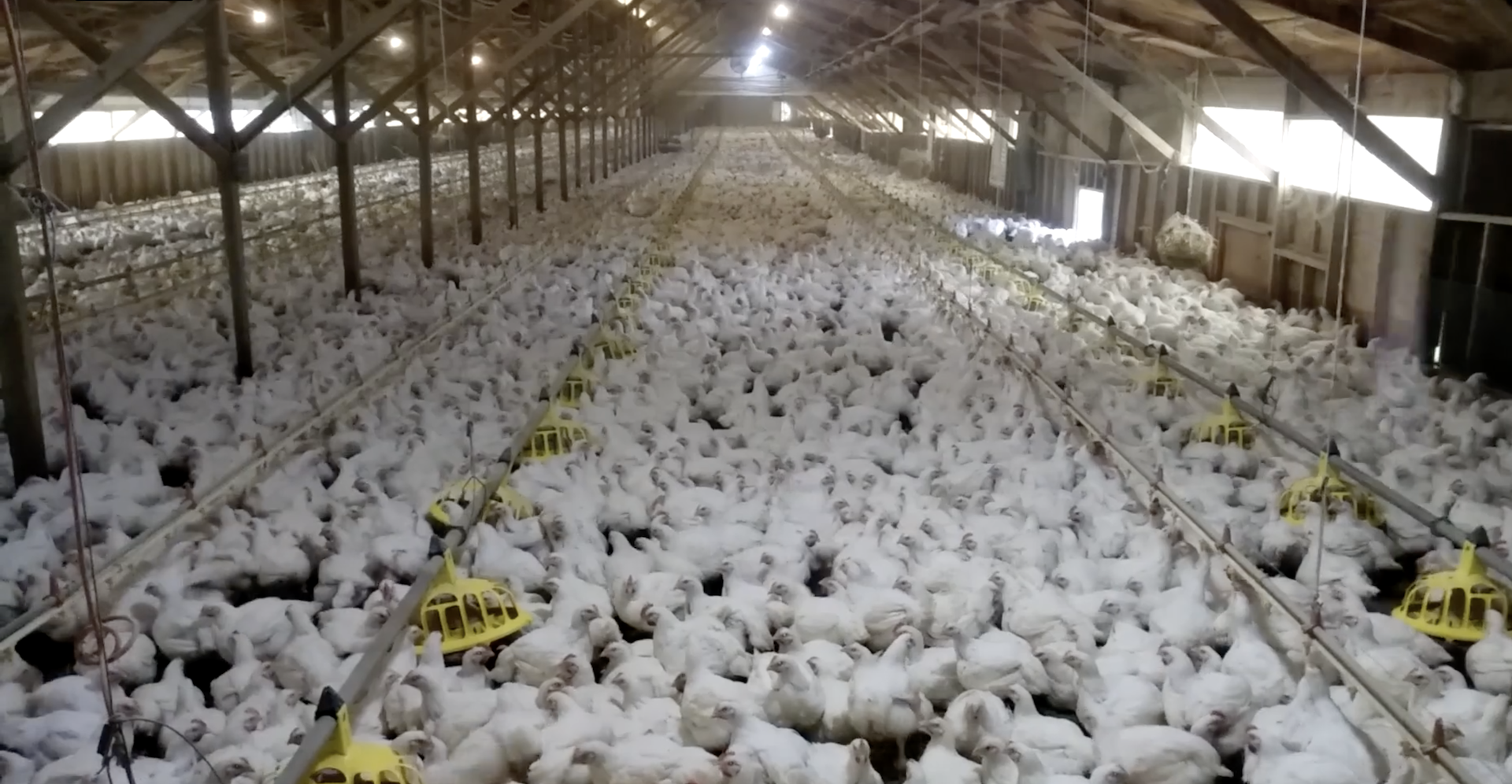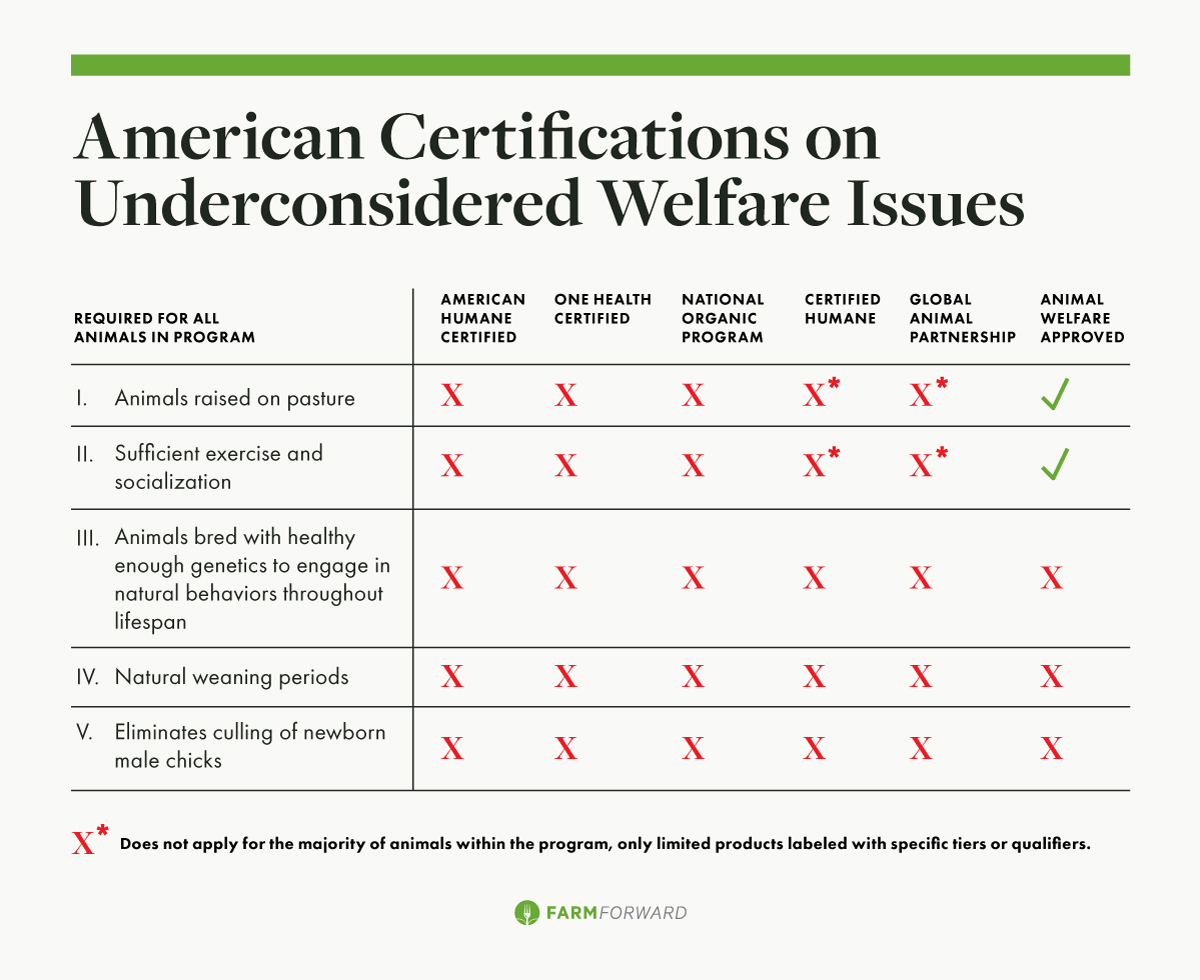Peeling back the labels
What is humanewashing?
For decades the American public has been subjected to rampant greenwashing, from ads about “clean coal” to “green” labels on toilet paper made from clear-cut forests. Now Farm Forward is peeling back the labels on meat, dairy, and egg packages to reveal a dangerous new trend that is growing in scope and sophistication within our food supply: humanewashing.
Simply finding a “humane” label on a product doesn’t make it so
Instead, these labels are often industry-driven humanewashing tools: efforts to market animal products to conscientious consumers through deceptive packaging and labeling, promoting the illusion of animal well-being while concealing the extent of animals’ illness and suffering.

Factory Farm (credit: We Animals Media)

Organic/Free Range (credit: Animal Outlook)
While the most basic of these tactics take the form of “all-natural” or “free range” labels, even independent welfare certifications have become embroiled in the dirty business of humanewashing. In our report “The Dirt on Humanewashing”, published on the heels of us resigning in protest from the board of the nation’s largest independent welfare certification, Global Animal Partnership (GAP), Farm Forward reveals that by putting their stamp of approval on factory-farmed products, certifications, too, are deceiving shoppers and betraying the animals whose welfare they are charged with overseeing.
Common “humane” and “healthy” claims and what they mean for animals
With an ever-expanding array of product labels and marketing confronting shoppers, it’s hard to know who and what to trust—but we know what we want the labels to mean: a 2021 Farm Forward survey found that 45 percent of Americans believe that all high welfare certifications need to ensure that animals are raised continuously on pasture, and more than half felt that the “cage-free” label should mean that chickens live on pasture. In reality, though, the smiling cows and hens on grocery store shelves belie the harsh reality for 99 percent of farmed animals: factory farming.1 Here are what common “humane” and “healthy” claims mean for animals:
Natural
Nothing. This term only refers to post-slaughter ingredients and additives.
Humanely raised
An unregulated term that does not ensure higher welfare standards.
Organic
The USDA’s National Organic Program does have specific standards that must be met for certification; however, the welfare components are weak. Animals should be given enough space to accommodate natural behaviors and provided outdoor access, but space requirements are not clearly spelled out, and animals generally have only slightly more room than on conventional farms. Animals cannot be given hormones or unnecessary antibiotics and must be fed an organic diet.
Hormone-free
No hormones given to dairy cows, but no requirements for welfare. No meaning for chicken, eggs, or pork, as hormones are already prohibited in these industries.
Cage-free
This term applies to virtually all chickens used for meat, who are raised indoors on factory farms, as cages are not used by the broiler industry. For egg-laying hens, cages are replaced with crowded indoor aviaries. No outdoor access is required.
Free-range
Birds must be given access to the outdoors, but actual outside time varies widely. Many birds on crowded farms may never use the small outdoor opening provided. This claim gives consumers no assurance that animals actually go outside.
Who is behind animal welfare labels?
What should shoppers make of all those certification seals and check marks that are on products? Certifications fall into three categories:
- Schemes created by meat industry groups like the National Chicken Council that merely obfuscate standard factory farming practices behind an authoritative-looking seal.
- Certifications run by organizations that appear to be watchdogs but are in fact deeply embedded with the meat industry: American Humane Certified (AHC), whose standards condone practices like crate confinement of mother pigs and dehorning of cows,2 and the new One Health Certified (OHC) created by the nation’s sixth largest poultry producer, Mountaire Farms, which embodies greenwashing, healthwashing, and humanewashing, all rolled into one.
- Independent certifications like Certified Humane and Global Animal Partnership (GAP). These labels can provide meaningful welfare improvements: both certifications, for instance, require environmental enrichments for chickens, prohibit debeaking birds and routinely tail docking pigs, and require cage-free housing for laying hens.3 4 However, the vast majority of the products they certify still come from factory farms where animals are subjected to conditions like confinement and unhealthy genetics.
Some of the most basic and least-considered welfare provisions, like those listed in the chart below, are simply incompatible with factory farming and are often left unresolved by even the most stringent certifications.5 The reality is that the certified “better” meat dominating grocery shelves is still cruel and overwhelmingly derived from genetically modified, unhealthy animals.

American Certifications on Underconsidered Welfare Issues
“Antibiotic-free” and humanewashing
Labels paint a rosy picture of our food system, obfuscating animal suffering as well as rampant drug use to keep animals alive in sickening conditions that would otherwise kill them. Farm Forward’s consumer survey revealed that 25 percent of Americans believe that an “antibiotic-free” label indicates that the animal was raised on pasture—despite the claim having no bearing on welfare.
In 2022, rigorous testing by Farm Forward found that “antibiotic-free” labels aren’t even delivering on their explicit promise. A sample of GAP Animal Welfare Certified™ and Organic Certified beef purchased at Whole Foods tested positive for monensin, an antibiotic used to promote growth that is banned by both programs. These results were corroborated by a peer-reviewed study in Science that found that over a quarter of GAP-certified cattle in their sample came from feedlots that had residues of medically important antibiotics.
Whole Foods and GAP have done nothing to ensure that animals treated with antibiotics don’t end up on store shelves. And even if Whole Foods did test its products, that wouldn’t eliminate the reason for widespread drug use in the first place: factory farming. If we can’t trust a supposed leader like Whole Foods, who can we trust to protect animals and consumers? Whole Foods must take factory farming off its shelves if it can’t live up to its promises.
What can you do?
Humanewashing fools us into paying higher prices for factory farmed products. So how can you shop according to your conscience? Our label guide helps shoppers identify the rare products that meet a minimum standard most of us expect: animals free to roam on pasture. However, for many shoppers, choosing to center plants on their plates is easier than decoding the sea of deceptive labels at the grocery store to find the few products that align with their values.
You can also make a difference by holding supermarkets and meat companies accountable. Supermarkets stock what their customers demand, so your voice matters.
Stay up to date
Join the movement for truth in labeling. Stay up to date on the latest humanewashing news.
Donate
Support Farm Forward’s work to expose meat industry humanewashing. Give today.
Humanewashing in the media
- Studies call into question ‘raised without antibiotics’ claims; Whole Foods named (April 12, 2022) | Food Safety News
- The “humanewashing” of America’s meat and dairy, explained (December 21, 2021) | VOX’s front cover story highlights the issue of humanewashing
- Do animal welfare certifications raise the bar for farm animals? (December 13, 2021) | Forbes covers deceptive labels
- Humanewashing: Think Those Labels Mean Something? (December 13, 2021) | What Doesn’t Kill You podcast interviews Farm Forward Executive Director
- Farm to Table Talk: Humanewashing – Ben Goldsmith (November 27, 2021) | We call out retailers and others in the food chains who are making animal welfare claims that cannot be substantiated
- The case against humane food labels (April 26, 2021) | Faunalytics asks: Has humane labeling largely become a marketing tool for agribusiness?
- Buying Meat? Don’t Believe What You Read on the Label (February 18, 2021) | Sentient Media covers our “Dirt on Humanewashing” report
- Are Some Animal Welfare Labels ‘Humanewashing’? (January 21, 2021) | Civil Eats digs in
- Whole Foods Gets Called Out For Its Misleading Animal Welfare Labels (January 2021) | Corby Kummer spoke to Boston Public Radio about our “Dirt on Humanewashing” report
Last Updated
April 9, 2022
Endnotes
1.
Farm Forward calculation based on U.S. Department of Agriculture 2012 Census of Agriculture, June 2014.
2.
American Humane Certified. 2020. “Science-Based Standards.” http://humaneheartland.org/our-standards/.
3.
Certified Humane. 2020. “Our Standards.” https://certifiedhumane.org/our-standards/.
4.
Global Animal Partnership. 2020. “Our Standards.” https://globalanimalpartnership.org/standards/.
5.
One independent certification, A Greener World’s (AGW’s) Animal Welfare Approved (AWA), stands out as anomalous: it is both the smallest and the most rigorous. It is the only certification that avoids the particularly disturbing humanewashing involved in certifying as humane products from animals raised in intensive confinement. However, AWA, too, struggles with the reality that other forms of cruelty, such as the forced separation of calves and mother cows before natural weaning or the use of genetic lines of chickens prone to disease and chronic pain, are so pervasive in modern animal agriculture that even it cannot insist that these cruelties be banned and continue to operate. Further, AWA’s high standards and commitment to protect smaller independent farmers have precluded its ability to scale to the level of other certifications like GAP. Indeed, it is difficult to imagine the circumstances under which the meat, poultry, dairy, and egg companies that dominate the industry today would adopt AWA standards at scale with options like AHC, Certified Humane, or GAP available. Thus, while AWA could partially be viewed as an exception to the humanewashing rule, its inability to achieve market scale is another datum illustrating the failure of animal welfare certification.